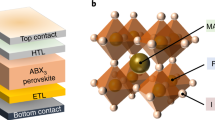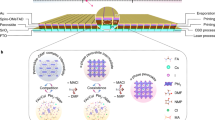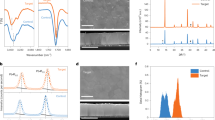Abstract
Obtaining micron-thick perovskite films of high quality is key to realizing efficient and stable positive (p)-intrinsic (i)-negative (n) perovskite solar cells1,2, but it remains a challenge. Here we report an effective method for producing high-quality, micron-thick formamidinium-based perovskite films by forming coherent grain boundaries, in which high-Miller-index-oriented grains grow on the low-Miller-index-oriented grains in a stabilized atmosphere. The resulting micron-thick perovskite films, with enhanced grain boundaries and grains, showed stable material properties and outstanding optoelectronic performances. The small-area solar cells achieved efficiencies of 26.1%. The 1-cm2 devices and 5 cm × 5 cm mini-modules delivered efficiencies of 24.3% and 21.4%, respectively. The devices processed in a stabilized atmosphere presented a high reproducibility across all four seasons. The encapsulated devices exhibited superior long-term stability under both light and thermal stressors in ambient air.
This is a preview of subscription content, access via your institution
Access options
Access Nature and 54 other Nature Portfolio journals
Get Nature+, our best-value online-access subscription
27,99 € / 30 days
cancel any time
Subscribe to this journal
Receive 51 print issues and online access
199,00 € per year
only 3,90 € per issue
Buy this article
- Purchase on SpringerLink
- Instant access to full article PDF
Prices may be subject to local taxes which are calculated during checkout




Similar content being viewed by others
References
Luo, D. et al. Minimizing non-radiative recombination losses in perovskite solar cells. Nat. Rev. Mater. 5, 44–60 (2019).
Chen, P. et al. Multifunctional ytterbium oxide buffer for perovskite solar cells. Nature 625, 516–522 (2024).
Jeng, J.-Y. et al. CH3NH3PbI3 perovskite/fullerene planar-heterojunction hybrid solar cells. Adv. Mater. 25, 3727–3732 (2013).
Liu, T. et al. Inverted perovskite solar cells: progresses and perspectives. Adv. Energy Mater. 6, 1600457 (2016).
Al-Ashouri, A. et al. Monolithic perovskite/silicon tandem solar cell with >29% efficiency by enhanced hole extraction. Science 370, 1300–1309 (2020).
Zheng, X. et al. Co-deposition of hole-selective contact and absorber for improving the processability of perovskite solar cells. Nat. Energy 8, 462–472 (2023).
Peng, W. et al. Reducing nonradiative recombination in perovskite solar cells with a porous insulator contact. Science 379, 683–690 (2023).
Min, H. et al. Efficient, stable solar cells by using inherent bandgap of α-phase formamidinium lead iodide. Science 366, 749–753 (2019).
Jeong, J. et al. Pseudo-halide anion engineering for α-FAPbI3 perovskite solar cells. Nature 592, 381–385 (2021).
Lin, Q. et al. Electro-optics of perovskite solar cells. Nat. Photon. 9, 106–112 (2015).
Luo, X. et al. Record photocurrent density over 26 mA cm−2 in planar perovskite solar cells enabled by antireflective cascaded electron transport layer. Sol. RRL 4, 2000169 (2020).
Zheng, X. et al. Managing grains and interfaces via ligand anchoring enables 22.3%-efficiency inverted perovskite solar cells. Nat. Energy 5, 131–140 (2020).
Bai, S. et al. Planar perovskite solar cells with long-term stability using ionic liquid additives. Nature 571, 245–250 (2019).
Chen, H. et al. Quantum-size-tuned heterostructures enable efficient and stable inverted perovskite solar cells. Nat. Photon. 16, 352–358 (2022).
Jiang, Q. et al. Surface reaction for efficient and stable inverted perovskite solar cells. Nature 611, 278–283 (2022).
Li, C. et al. Rational design of Lewis base molecules for stable and efficient inverted perovskite solar cells. Science 379, 690–694 (2023).
Luo, D. et al. Enhanced photovoltage for inverted planar heterojunction perovskite solar cells. Science 360, 1442–1446 (2018).
Li, X. et al. Constructing heterojunctions by surface sulfidation for efficient inverted perovskite solar cells. Science 375, 434–437 (2022).
Liu, X. et al. Stabilization of photoactive phases for perovskite photovoltaics. Nat. Rev. Chem. 7, 462–479 (2023).
Park, S. M. et al. Engineering ligand reactivity enables high-temperature operation of stable perovskite solar cells. Science 381, 209–215 (2023).
Ma, C. et al. Unveiling facet-dependent degradation and facet engineering for stable perovskite solar cells. Science 379, 173–178 (2023).
Geelhaar, L. et al. GaAs (2 5 11): a new stable surface within the stereographic triangle. Phys. Rev. Lett. 86, 3815–3818 (2001).
Geelhaar, L., Temko, Y., Márquez, J., Krater, P. & Jacobi, K. Surface structure of GaAs (2 5 11). Phys. Rev. B 65, 155308 (2002).
Shi, P. et al. Oriented nucleation in formamidinium perovskite for photovoltaics. Nature 620, 323–327 (2023).
Wang, Y. et al. Unlocking the ambient temperature effect on FA-based perovskites crystallization by in situ optical method. Adv. Mater. 36, e2307635 (2024).
Braly, I. L. et al. Hybrid perovskite films approaching the radiative limit with over 90% photoluminescence quantum efficiency. Nat. Photon. 12, 355–361 (2018).
Tan, Q. et al. Inverted perovskite solar cells using dimethylacridine-based dopants. Nature 620, 545–551 (2023).
Zhang, S. et al. Minimizing buried interfacial defects for efficient inverted perovskite solar cells. Science 380, 404–409 (2023).
Cho, C. et al. Efficient vertical charge transport in polycrystalline halide perovskites revealed by four-dimensional tracking of charge carriers. Nat. Mater. 21, 1388–1395 (2022).
Zhu, Y. et al. Direct atomic scale characterization of the surface structure and planar defects in the organic-inorganic hybrid CH3NH3PbI3 by Cryo-TEM. Nano Energy 73, 104820 (2020).
Zhao, L. et al. Enabling full-scale grain boundary mitigation in polycrystalline perovskite solids. Sci. Adv. 8, eabo3733 (2022).
Xu, W. et al. Impact of interface energetic alignment and mobile ions on charge carrier accumulation and extraction in p-i-n perovskite solar cells. Adv. Energy Mater. 13, 2301102 (2023).
Caprioglio, P. et al. On the origin of the ideality factor in perovskite solar cells. Adv. Energy Mater. 10, 2000502 (2020).
Caprioglio, P. et al. Open-circuit and short-circuit loss management in wide-gap perovskite p-i-n solar cells. Nat. Commun. 14, 932 (2023).
Khenkin, M. V. et al. Consensus statement for stability assessment and reporting for perovskite photovoltaics based on ISOS procedures. Nat. Energy 5, 35–49 (2020).
Yu, M. et al. High‐radiance near‐infrared perovskite light‐emitting diodes with improved roll‐off degradation. Adv. Opt. Mater. 11, 2202043 (2022).
Sjöström, M. & Squire, J. M. Cryo-ultramicrotomy and myofibrillar fine structure: a review. J. Microsc. 111, 239–278 (1977).
Zhang, H., Wang, C. & Zhou, G. Ultra-microtome for the preparation of TEM specimens from battery cathodes. Microsc. Microanal. 26, 867–877 (2020).
Kresse, G. & Furthmüller, J. Efficiency of ab-initio total energy calculations for metals and semiconductors using a plane-wave basis set. Comput. Mater. Sci. 6, 15–50 (1996).
Kresse, G. & Joubert, D. From ultrasoft pseudopotentials to the projector augmented-wave method. Phys. Rev. B 59, 1758–1775 (1999).
Blöchl, P. E. Projector augmented-wave method. Phys. Rev. B 50, 17953–17979 (1994).
Liu, N. & Yam, C. First-principles study of intrinsic defects in formamidinium lead triiodide perovskite solar cell absorbers. Phys. Chem. Chem. Phys. 20, 6800–6804 (2018).
Haruyama, J., Sodeyama, K., Han, L. & Tateyama, Y. Termination dependence of tetragonal CH3NH3PbI3 surfaces for perovskite solar cells. J. Phys. Chem. Lett. 5, 2903–2909 (2014).
Frohna, K. et al. Nanoscale chemical heterogeneity dominates the optoelectronic response of alloyed perovskite solar cells. Nat. Nanotechnol. 17, 190–196 (2022).
Acknowledgements
This work was financially supported by the National Natural Science Foundation of China (52325310, 52203208, 52403369 and 52303217), the Beijing Natural Science Foundation (JQ21005), the National Key R&D Program of China (2021YFB3800100, 2021YFB3800101 and 2021YFB3802400), the open research fund of Songshan Lake Materials Laboratory (2022SLABFK07), the Yunnan Provincial Science and Technology Project at Southwest United Graduate School (202302AO370013), the Natural Science Foundation of Jiangsu Province (BK20220302), the Nantong Basic Science Research Program (JC12022036) and the R&D Fruit Fund (20210001). This work was also sponsored by the Beijing Nova Program (20220484148 and 20230484480). H.J.S. acknowledges funding from the Engineering and Physical Sciences Research Council (EPSRC) (grant no. EP/S004947/1). S.D.S. acknowledges the Royal Society and Tata Group (grant no. UF150033) and funding from the European Research Council under the Horizon 2020 research and innovation programme of the European Union (HYPERION, grant agreement no. 756962; PEROVSCI, 957513) and EPSRC (EP/R023980/1, EP/V027131/1 and EP/V012932/1). K.S.N. acknowledges support from the Ministry of Education, Singapore (Research Centre of Excellence award to the Institute for Functional Intelligent Materials, I-FIM, project no. EDUNC-33-18-279-V12), and from the Royal Society (UK, grant no. RSRP\R\190000). J.R.D. acknowledges the funding from the Application Targeted and Integrated Photovoltaics (ATIP) project (EP/T028513/1) from EPSRC. Y.X. acknowledges the China Oxford Scholarship Fund and the GCRF grant from Research England. L.D. acknowledges funding support from European Research Council under the European Union’s Horizon 2020 research and innovation programme (ERC fundings: PEROVSCI, 957513 & HYPERION, 756962) and UKRI Horizon Europe Guarantee MSCA Marie Skłodowska-Curie Postdoctoral Fellowship (EP/Y029429/1). S.J.Z. acknowledges support from the Polish National Agency for Academic Exchange within the Bekker program (grant no. PPN/BEK/2020/1/00264/U/00001). K.A.E. acknowledges the support of the Rank Prize through a Return to Research grant. M.D. and S.D.S. thank the Leverhulme Trust (RPG-2021-191) for funding. M.D. acknowledges UKRI guarantee funding for Marie Sklodowska-Curie Actions Postdoctoral Fellowships 2022 (EP/Y024648/1). C.C. acknowledges the support of a Marshall Scholarship and a Winton Scholarship. I.H. acknowledges the Oppenheimer Memorial Trust and the Firstrand Foundation for funding. P.H. acknowledges the computational resources at the National Supercomputing Center of Singapore (NSCC). Y.X. acknowledges M. Riede and P. Kaienburg from Oxford University for their general advice. W.X. acknowledges B. Moss for help with operando photoluminescence setup development and L. J. F. Hart for assistance on the measurement.
Author information
Authors and Affiliations
Contributions
D.L. and R.Z. conceived the project idea. D.L., S.D.S., H.J.S., R.Z., S.L., Y.X. and R.S. designed the experiments. S.L., P. Chen., T.H., Z.L., Y.X., H.-H.C., C.L. and J. Wu fabricated the PSCs and characterized the photovoltaic performances. S.L. and P. Chen. performed the EQE measurements of the PSCs. R.S. performed the optical simulation and did data analysis. B.H. conducted the Cryo-TEM sample preparation, tests and data analysis. P.H. and K.S.N. contributed to the DFT calculations. R.S., I.H., Y.X. and D.W. contributed to the tests and fitting of the optical constant of materials used in the optical simulation. K.A.E., L.M.H. and Y.X. contributed to the analysis of charge-carrier transport inside micron-thick perovskite absorbers. W.X., S.D.S and J.R.D. contributed to the analysis of operando photoluminescence and electroluminescence. M.D., C.C. and W.X. contributed to the analysis of hyperspectral microscopy. W.X., D.G. and L.D. performed the TRPL measurements and did data analysis. S.L. and Y.X. performed the light absorption measurements. S.L. and L.Z. contributed to the analysis of the XRD data. J.H. performed REELS, UPS and XPS measurements. J.H., D.L., R.S. and Z.-H.L. contributed to the analysis of REELS, UPS and XPS results. Y.B. and S.J.Z. contributed to the PDS measurements and did data analysis. L.D. and B.A.I.L. contributed to the TA measurements and did data analysis. Y.X., P. Caprioglio and A.D. contributed to the analysis of QFLS and VOC limits. Jianpu Wang and Jingmin Wang contributed to the PLQY results. S.L., J.H., H.Y., Q.L. and L.Z. contributed to the SEM measurements and did data analysis. S.L., H.Y. and Y.X. performed the stability test. D.L., Q.G., S.D.S., H.J.S. and R.Z. directed and supervised the project. S.L. R.S. and Y.X. wrote the first draft of the paper. D.L., B.H., Q.G., S.D.S., H.J.S. and R.Z. revised the paper. All authors analysed their data and reviewed and commented on the paper.
Corresponding authors
Ethics declarations
Competing interests
H.J.S. is a co-founder and the Chief Scientific Officer of Oxford PV, a company commercializing perovskite solar cells. S.D.S. is a co-founder of Swift Solar. All other authors declare no competing interests.
Peer review
Peer review information
Nature thanks Yongsheng Liu and the other, anonymous, reviewer(s) for their contribution to the peer review of this work.
Additional information
Publisher’s note Springer Nature remains neutral with regard to jurisdictional claims in published maps and institutional affiliations.
Supplementary information
Supplementary Information
This file contains Supplementary Notes 1–7, Supplementary Figs. 1–45, Supplementary Tables 1–4 and Supplementary References.
Rights and permissions
Springer Nature or its licensor (e.g. a society or other partner) holds exclusive rights to this article under a publishing agreement with the author(s) or other rightsholder(s); author self-archiving of the accepted manuscript version of this article is solely governed by the terms of such publishing agreement and applicable law.
About this article
Cite this article
Li, S., Xiao, Y., Su, R. et al. Coherent growth of high-Miller-index facets enhances perovskite solar cells. Nature 635, 874–881 (2024). https://doi.org/10.1038/s41586-024-08159-5
Received:
Accepted:
Published:
Issue Date:
DOI: https://doi.org/10.1038/s41586-024-08159-5
This article is cited by
-
Solvent-assisted reaction for spontaneous defect passivation in perovskite solar cells
Nature Photonics (2025)
-
Improved photoelectric performance of perovskite solar cells with interfacial dipole molecules
Science China Chemistry (2025)
-
Cost Effectivities Analysis of Perovskite Solar Cells: Will it Outperform Crystalline Silicon Ones?
Nano-Micro Letters (2025)
-
Highlights of mainstream solar cell efficiencies in 2024
Frontiers in Energy (2025)



